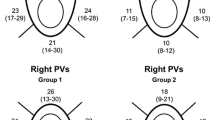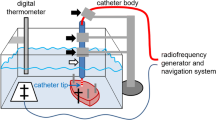Abstract
Purpose
Contact with cardiac tissue is a determinant of lesion efficacy during atrial fibrillation (AF) ablation. The Sensei®X Robotic Catheter System (Hansen Medical, CA) has been validated for contact force sensing. The electrical coupling index (ECI) from the EnSite Contact™ system (St. Jude Medical, MN) has been validated as an indicator of tissue contact. We aimed at analyzing ECI behavior during radiofrequency (RF) pulses maintaining a stable contact through the robotic navigation contact system.
Methods
In 15 patients (age, 59 ± 12) undergoing AF ablation, pulmonary vein (PV) isolation was guided by the Sensei®X System, employing the Contact™ catheter.
Results
During the procedure, we assessed ECI changes associated with adequate contact based on the IntelliSense® force-sensing technology (Hansen Medical, CA. Baseline contact (27 ± 8 g/cm2) ECI value was 99 ± 13, whereas ECI values in a noncontact site (0 g/cm2) and in a light contact site (1–10 g/cm2) were respectively 66 ± 12 and 77 ± 10 (p < 0.0001). Baseline contact ECI values were not different depending on AF presentation (paroxysmal AF, 98 ± 9; persistent AF, 100 ± 9) or on cardiac rhythm (sinus rhythm, 97 ± 7; AF,101 ± 10). In all PVs, ECI was significantly reduced during and after ablation (ECI during RF, 56 ± 15; ECI after RF, 72 ± 16; p < 0.001). A mean reduction of 32.2 % during RF delivery and 25.4 % immediately after RF discontinuation compared with baseline ECI was observed.
Conclusions
Successful PV isolation is associated with a significant decrease in ECI of at least 20 %. This may be used as a surrogate marker of effective lesion in AF ablation.



Similar content being viewed by others
References
Calkins, H., Kuck, K. H., Cappato, R., Brugada, J., Camm, A. J., Chen, S. A., et al. (2012). 2012 HRS/EHRA/ECAS expert consensus statement on catheter and surgical ablation of atrial fibrillation: recommendations for patient selection, procedural techniques, patient management and follow-up, definitions, endpoints, and research trial design: a report of the Heart Rhythm Society (HRS) Task Force on Catheter and Surgical Ablation of Atrial Fibrillation. Journal of Interventional Cardiac Electrophysiology, 33(2), 171–257.
Fuster, V., Rydén, L. E., Cannom, D. S., Crijns, H. J., Curtis, A. B., Ellenbogen, K. A., et al. (2011). 2011 ACCF/AHA/HRS focused updates incorporated into the ACC/AHA/ESC 2006 guidelines for the management of patients with atrial fibrillation: a report of the American College of Cardiology Foundation/American Heart Association Task Force on practice guidelines. Circulation, 123(10), e269–e367.
European Heart Rhythm Association, European Association for Cardio-Thoracic Surgery, Camm, A. J., Kirchhof, P., Lip, G. Y., Schotten, U., et al. (2010). ESC Committee for Practice Guidelines. Guidelines for the management of atrial fibrillation: the Task Force for the Management of Atrial Fibrillation of the European Society of Cardiology. Europace, 12(10), 1360–1420.
Holmes, D., Fish, J. M., Byrd, I. A., Dando, J. D., Fowler, S. J., Cao, H., et al. (2011). Contact sensing provides a highly accurate means to titrate radiofrequency ablation lesion depth. Journal of Cardiovascular Electrophysiology, 22(6), 684–690.
Haqqani, H. M., & Marchlinski, F. E. (2010). Creating lesions and indexing transmural ablation: pushing harder to find the Holy Grail. Journal of Cardiovascular Electrophysiology, 21(7), 812–814.
Wittkampf, F. H., & Nakagawa, H. (2006). RF catheter ablation: lessons on lesions. Pacing and Clinical Electrophysiology, 29, 1285–1297.
Zheng, X., Walcott, G. P., Hall, J. A., Rollins, D. L., Smith, W. M., Kay, G. N., et al. (2000). Electrode impedance: an indicator of electrode-tissue contact and lesion dimensions during linear ablation. Journal of Interventional Cardiac Electrophysiology, 4(4), 645–654.
Weiss, C., Antz, M., Eick, O., Eshagzaiy, K., Meinertz, T., & Willems, S. (2002). Radiofrequency catheter ablation using cooled electrodes: impact of irrigation flow rate and catheter contact on lesion dimensions. Pacing and Clinical Electrophysiology, 25(4), 463–469.
Schwartzman, D., Michele, J. J., Trankiem, C. T., & Ren, J. F. (2001). Electrogram-guided radiofrequency catheter ablation of atrial tissue comparison with thermometry-guide ablation. Journal of Interventional Cardiac Electrophysiology, 5, 253–266.
Thomas, D., Scholz, E. P., Schweizer, P. A., Katus, H. A., & Becker, R. (2012). Initial experience with robotic navigation for catheter ablation of paroxysmal and persistent atrial fibrillation. Journal of Electrocardiology, 45(2), 95–101.
Saliba, W., Reddy, V. Y., Wazni, O., Cummings, J. E., Burkhardt, J. D., Haissaguerre, M., et al. (2008). Atrial fibrillation ablation using a robotic catheter remote control system: initial human experience and long-term follow-up results. Journal of the American College of Cardiology, 51(25), 2407–2411.
Di Biase, L., Natale, A., Barrett, C., Tan, C., Elayi, C. S., Ching, C. K., et al. (2009). Relationship between catheter forces, lesion characteristics, “popping,” and char formation: experience with robotic navigation system. Journal of Cardiovascular Electrophysiology, 20(4), 436–440.
Piorkowski, C., Sih, H., Sommer, P., Miller, S. P., Gaspar, T., Teplitsky, L., et al. (2009). First in human validation of impedance-based catheter tip-to-tissue contact assessment in the left atrium. Journal of Cardiovascular Electrophysiology, 20(12), 1366–1373.
Deno, D. C., Sih, H., Miller, S., Teplitsky, L., Kuenzi, R. (2013). Measurement of electrical coupling between cardiac ablation catheters and tissue. IEEE Transactions on Biomedical Engineering.
Thiagalingam, A., D’Avila, A., Foley, L., Guerrero, J. L., Lambert, H., Leo, G., et al. (2010). Importance of catheter contact force during irrigated radiofrequency ablation: evaluation in a porcine ex vivo model using a force-sensing catheter. Journal of Cardiovascular Electrophysiology, 21(7), 806–811.
Haldar, S., Jarman, J. W., Panikker, S., Jones, D. G., Salukhe, T., Gupta, D., et al. (2013). Contact force sensing technology identifies sites of inadequate contact and reduces acute pulmonary vein reconnection: a prospective case control study. International Journal of Cardiology, 168(2), 1160–1166.
Sacher, F., Wright, M., Derval, N., Denis, A., Ramoul, K., Roten, L., et al. (2013). Endocardial versus epicardial ventricular radiofrequency ablation: utility of in vivo contact force assessment. Circulation. Arrhythmia and Electrophysiology, 6(1), 144–150.
Yokoyama, K., Nakagawa, H., Shah, D. C., Lambert, H., Leo, G., Aeby, N., et al. (2008). Novel contact force sensor incorporated in irrigated radiofrequency ablation catheter predicts lesion size and incidence of steam pop and thrombus. Circulation. Arrhythmia and Electrophysiology, 1(5), 354–362.
Okumura, Y., Johnson, S. B., Bunch, T. J., Henz, B. D., O’Brien, C. J., & Packer, D. L. (2008). A systematical analysis of in vivo contact forces on virtual catheter tip/tissue surface contact during cardiac mapping and intervention. Journal of Cardiovascular Electrophysiology, 19(6), 632–640.
Gaspar, T., Sih, H., Hindricks, G., Eitel, C., Sommer, P., Kircher, S., et al. (2013). Use of electrical coupling information in AF catheter ablation: a prospective randomized pilot study. Heart Rhythm, 10(2), 176–181.
Acknowledgments
The authors wish to thank Eng. Elena Romanelli, Pasquale De Iuliis, Enrico Romano, and Antonio Mininno (St. Jude Medical) for their technical support in NavX mapping and data analysis and Eng Guido Panfili (Abmedica) and Matteo Vernich (Hansen Medical) for technical support.
Disclosures
Antonio Dello Russo, Michela Casella, Fabrizio Bologna, Osama Al-Nono, Daniele Colombo, Viviana Biagioli, Pasquale Santangeli, Martina Zucchetti, Benedetta Majocchi, Vittoria Marino, Joseph J Gallinghouse have no relationships or conflicts to disclose. Gaetano Fassini serves as consultant for Medtronic and Biosense-Webster. Luigi Di Biase serves as consultant for Hansen Medical and Biosense-Webster. Andrea Natale has received compensation for belonging to the speakers’ bureau for St. Jude Medical, Boston Scientific, Medtronic, and Biosense-Webster. Dr. Natale is a consultant for Biosense-Webster. Claudio Tondo serves as member of the Advisory Board of Medtronic and is also a consultant for and receives lecture fees from St. Jude Medical
Author information
Authors and Affiliations
Corresponding author
Electronic supplementary material
Below is the link to the electronic supplementary material.
(MPG 4685 kb)
(MPG 5358 kb)
(MPG 4268 kb)
Rights and permissions
About this article
Cite this article
Dello Russo, A., Fassini, G., Casella, M. et al. Simultaneous assessment of contact pressure and local electrical coupling index using robotic navigation. J Interv Card Electrophysiol 40, 23–31 (2014). https://doi.org/10.1007/s10840-014-9882-2
Received:
Accepted:
Published:
Issue Date:
DOI: https://doi.org/10.1007/s10840-014-9882-2




